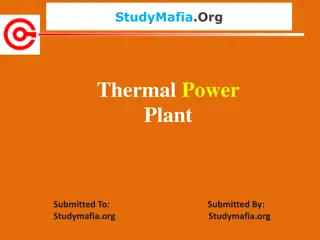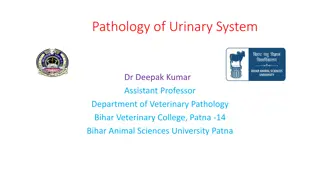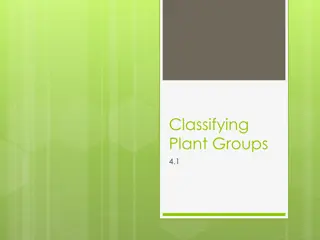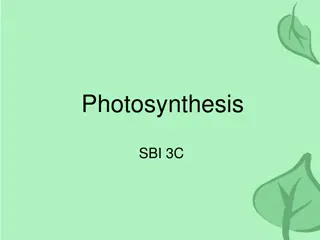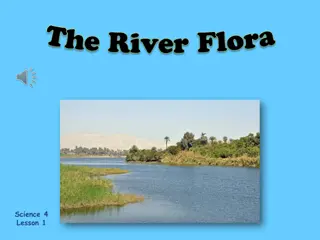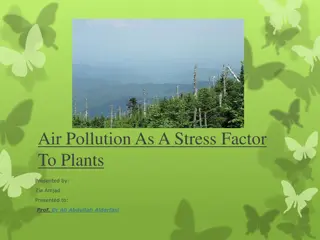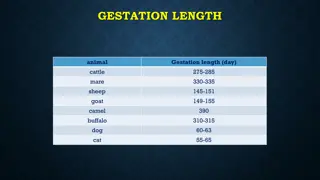Factors Affecting Global Distribution of Plants and Animals
The distribution of plants and animals worldwide is influenced by abiotic and biotic factors. Factors such as rocks, food availability, air quality, water supply, and soil type play crucial roles in determining where species thrive. From the availability of nutrients like nitrogen and phosphorus to the necessity of water for various vital functions, each factor contributes to the diversity and distribution of terrestrial and aquatic organisms.
Download Presentation

Please find below an Image/Link to download the presentation.
The content on the website is provided AS IS for your information and personal use only. It may not be sold, licensed, or shared on other websites without obtaining consent from the author.If you encounter any issues during the download, it is possible that the publisher has removed the file from their server.
You are allowed to download the files provided on this website for personal or commercial use, subject to the condition that they are used lawfully. All files are the property of their respective owners.
The content on the website is provided AS IS for your information and personal use only. It may not be sold, licensed, or shared on other websites without obtaining consent from the author.
E N D
Presentation Transcript
B.A 2NDSEMESTER PAPER 2026 CLIMATOLOGY AND BIOGEOGRAPHY
Factors affecting the world distribution of plants and animals There are diversities in species in plants and animals. Plants and animals are Terrestrial and Aquatic. Diversities of plants and animals are found from the Equator to Pole, and from Foothills to Mountain Top. Humans, animals, and plants are globally distributed, they are termed cosmopolitan in their distribution some other animals have restricted distribution and they are said to be endemic. Cosmopolitan same and similar species widely distributed all over the world. Endemic same and similar species occurring in the same geographical location and in no other place.
The global distribution of plants and animals depends on abiotic and biotic factors; the abiotic are the non-living factors and also the biotic factors or the living factors. Abiotic factors affecting distribution of plants and animals 1. Rocks the rocks of the lithosphere have to be weathered and the soil has to be formed before a plant to grow. The immediate environmental factor affecting the plant is therefore the soil and these soil characteristics mostly depend on the parent rock. Rocks favor certain plants; and, in some instances, differences in rocks adapt them to different species of Lichens and Mosses.
2. Food All living species must have food to survive, without the food they die, this is one of the foundations for the differences in limitation of plants, animal in different locations of the world. 3. Air All living things (plants and animals) need air to breathe and for survival, the air is needed for respiration to take place in organisms. All living organisms only survive where there is air in abundance, when the air pressure is low, especially in higher altitudes some may find it difficult to breathe because of the insufficient amount of oxygen present at such height. Oxygen and carbon dioxides are very important for both plants and animals, oxygen is essential for respiration and it is utilized during various growth and development process, while carbon dioxide is needed for photosynthesis to take place.
4. Water Water enters the ecosystem through snow, drizzle, sleet, rain, hail which are generally termed as precipitation. Precipitation determines, along with mean temperature, the worldwide distribution of Biomes. Some animals are aquatic in nature, they must have water to live in, and on the other hand, some animals including desert rats are able to survive in arid areas where they are unlikely ever to drink water. Water is very important for vital functions, however, only animals that can conserve water are found in the deserts 5. Nutrients Nitrogen is needed to make proteins, enzymes, nucleotides, and vitamins. Phosphorus is used in the formation of phospholipids and other structures.
6. Soil For plants, soil type is a major factor in deciding the type and variety of species growing in a particular area as the minerals, water contents, microorganisms, etc. all differ in different soils. Soil is a combination of various organic and inorganic matters and with varying content, the water retention capacity of the soil, the fertility, and the presence of minerals changes 7.Temperature The ability to survive at extremes temperatures varies widely among plants and animals. Animals respond to variation in temperature both physiologically and behaviorally. For instance, birds and mammals are hot blooded animals (endotherms); they maintain relatively high body temperatures using the heat by their own metabolism. Other animals (such as insects, reptiles, amphibians, fish among others) are termed cold-blooded (ectotherms), they regulate their body temperatures using the surrounding temperature or by using the ambient temperature.
8. Light Light is an important climatic factor that is used for the production of chlorophyll and photosynthesis; light has a big influence on the daily and seasonal activity of plants and animals. Light is need for photosynthesis to take place and it is the main source of energy in almost all ecosystems. Energy enters the ecosystem through the source of light- the sun. Biotic factors affecting distribution of plants and animals 1.Competition Competitive interactions have been seen to be one of the major factors that diminish populations of plants and animals from their main habitats; plants and animals compete for space, space is needed for reproduction, exercise, and feeding.
2.Predation Predation affects the global distribution and abundance of plant and animal species, the strength and direction of energy flow within a system, and the diversity and composition of communities. Predators also play an essential role in evolution. 3.Diseases Plant diseases can be fungal, bacterial, viral, or through an animal in origin; they include insects/pests, plant diseases, and invasive weeds. These diseases affect food crops, causing significant losses to farmers and threatening food security 4.Humans Humans can influence animal and plant populations in various ways hence, causing them to migrate away from their natural habitat to a new environment. When humans develop land for houses and buildings, they cut down trees and change animal and plant habitats








